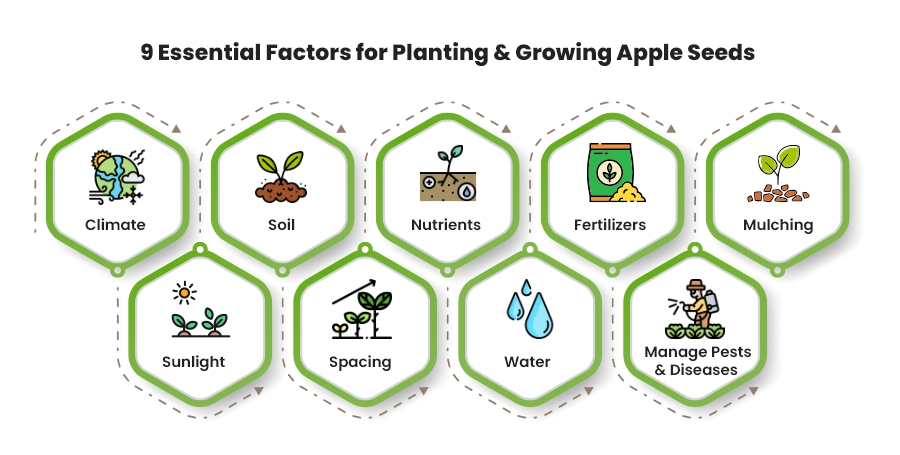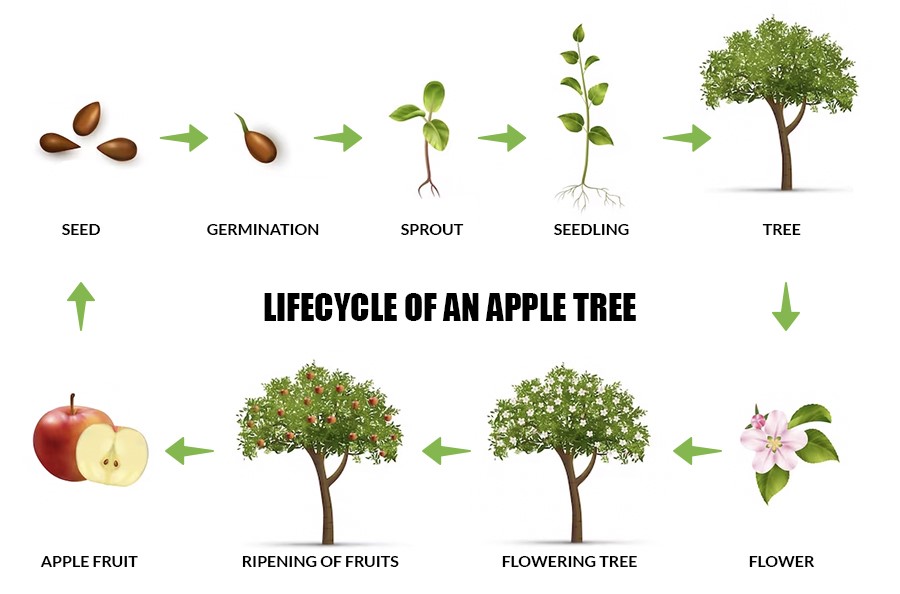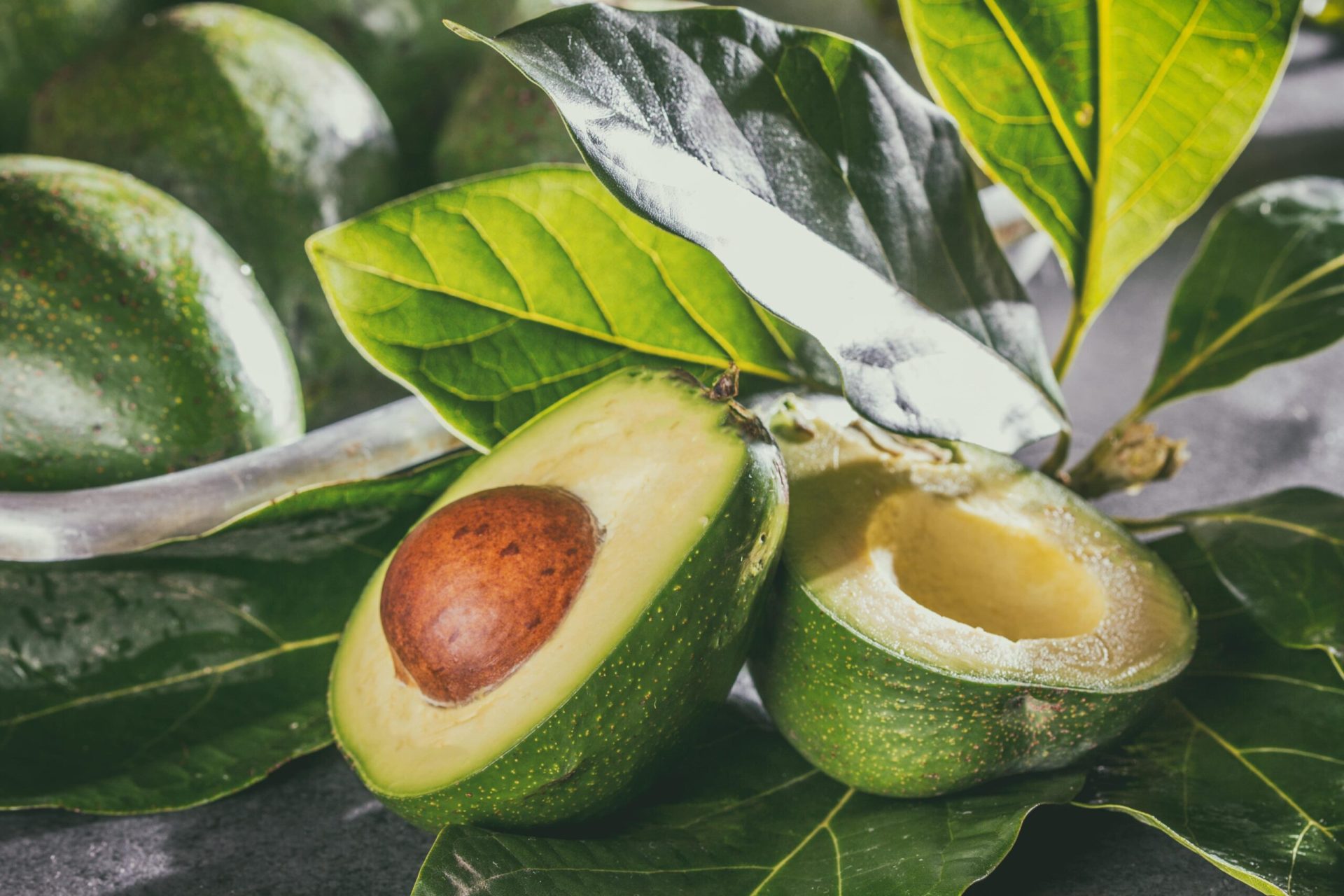Growing apples at home is a rewarding endeavor. Imagine stepping into your backyard, plucking a crisp red apple from a tree, and savoring its taste.
Fortunately, growing apple trees is fairly straightforward. This guide walks you through the entire process: From selecting the right type of apple seeds, to choosing the best apple varietals to grow.
Selecting the Right Type of Apple Tree to Grow
When selecting an apple variety to grow, you should determine whether you want to eat or cook apples or both. There are different apple varieties in the market, each with a unique flavor, sweetness (or tartness) level, texture, harvest time, and storage potential.
Additionally, some varieties are better suited for colder or warmer climates. Some of the most popular homegrown apples include:
- Red Delicious: Known for its deep red color and sweet flavor, the Red Delicious apple is a classic choice for home gardeners.
- Granny Smith: With a bright green skin and tart flavor, Granny Smith apples are popular for baking and making pies.
- Fuji: Fuji apples are sweet, juicy, and crisp, making them great for fresh eating. They have a red and yellow skin.
- Honeycrisp: Honeycrisp apples are known for their sweet and crisp texture. They are excellent for both fresh eating and salads.
- Gala: Gala apples are sweet and have a mild flavor. They are often enjoyed as a snack and can be used for applesauce.
- Braeburn: These apples are sweet and tart with a crisp texture. They are versatile and can be used for both eating fresh and baking.
If you have limited space, choose a dwarf variety. Smaller, dwarf apple trees may grow well in five-gallon buckets or a larger container, depending on the variety.
Pro Tip. If an apple tree is described as “hardy,” it typically thrives best in USDA Hardiness Zones 3 to 5. The greatest zones for apples, if they are considered “long-season,” are Zones 5 to 8. It takes a specific number of chill hours for each variety’s fruit to set. More chill hours are required for an apple variety to avoid late spring freeze issues the further north you go.
Can You Harvest Seeds from Store-Bought Apples?
Yes, you can grow apple trees from store-bought seeds, but keep in mind:
1. Variability
The apples from these trees may not resemble the parent apple.
2. Long Time to Fruit
It takes many years for seed-grown trees to bear fruit.
3. Rootstock and Disease Resistance
You won’t have control over rootstock or disease resistance.
For specific apple varieties, faster fruiting, and control over tree characteristics, it’s better to buy grafted nursery trees. Seed-grown trees are more for educational purposes.
Should You Grow Trees from Seed or Buy from a Nursery?
Growing apple trees from seed can be rewarding. However, there are some limitations. This process, for one, takes a long time to fruit. You can start producing apples from nursery-grown trees much faster.
Additionally, you won’t have access to rootstock. Most nursery-grown trees are produced by grafting. This means a tree is grafted to rootstock chosen for a specific soil type, as well as disease resistance. Therefore, seed-grown apples tend to have unpredictable quality and are more prone to disease.
Essential Factors to Consider

1. Climate
Apples are a temperate fruit crop. They tend to thrive well in the climate with cold winters, and moderate summers with medium to high humidity. Apple trees grow well in climates with summer temperatures that rarely creep above 90 degrees.
2. Sunlight
Apple trees love sunlight and require at least six to eight hours of sunlight daily during their growing stage. You should plant them in direct sunlight but in a sheltered spot. If you’re planting your trees in early spring, be sure to protect against frost. This a “Full Sun” tree.
3. Soil
Sandy or loamy soil is best for optimum growth of apple trees. These soils are bit acidic, well-draining, and fertile, so they have all the conditions for growing apple trees. Prior to planting a tree, be sure to amend the soil around it to ensure drainage.
Apple trees should be able to retain some moisture even though they require well-drained soil. It is recommended to have light- to medium-textured soil. Fruit trees struggle in heavy clay soil, and root rot disease is brought on by poorly drained soil.
4. Spacing
The amount of spacing required by apple trees depends on the variety and size of the mature tree. You should space apple trees about 10 to 15 feet apart to allow proper air circulation and adequate sunlight. Dwarf or semi-dwarf varieties require less space, about 6 to 10 feet between trees.
5. Nutrients
The development of an apple tree requires nutrients like potassium, nitrogen, and phosphorus. It helps in the proper growth and development of the tree. Feed your apple trees with these nutrients in the early stages of their growth.
6. Water
If you plant apple trees in well-drained soil, you should give them sufficient water. Watering once every seven to ten days is adequate. You can regulate this water schedule depending on the rainfall in your location.
Adding 1 inch of water weekly will help develop the plant, a well-established root system. You can add 2 inches of water every week for young apple trees.
7. Fertilization
High-nitrogen fertilizers work best for apple trees. You can use organic fertilizers to provide essential nutrients to trees to grow healthy apples over the years. The best time to add fertilizer is in the spring. After planting, give each tree plenty of water and fertilize with a liquid starter fertilizer with a high phosphorus content. For every year the tree has been alive, feed it half a pound of balanced 10-10-10 fertilizer, up to a maximum of 10 pounds per tree every year.
8. Pest and Disease Management
Certain factors like plant disease, pests, wildlife, or insects affect the appearance and health of young apple trees. Use fungicides (organic options are available) or sprays to protect apple trees from disease.
Fruit trees like apples or avocado trees risk developing fungal leaf diseases if they are not planted in an area with excellent air circulation so that leaves may quickly dry after irrigation or rainfall.
9. Mulching
Mulching your trees preserves soil moisture and prevents the growth of unwanted grass or weeds on the surface. Depending on the type of tree you have planted, add a 6- to 12-inch layer of mulch to it. Refresh the mulch regularly and pull it away from the trunk so that it doesn’t cause the tree to rot.
Tips for Transplanting Young Apple Trees
To transplant apple seedlings into the ground, do it when the temperature is consistently above 50 degrees during spring. After transferring the seedlings to the ground, they grow into a full-size tree.
Remove all weeds and the grass in a 4-foot-diameter circle before planting. Once the tree has been purchased, keep it safe from harm, drying out, freezing, or overheating. If the roots have dried out, soak them in water for about 24 hours prior to planting.
When you’re reading to plant an apple tree, follow these tips for success:
- Prepare Soil: Test and amend the soil as needed for good drainage and pH.
- Plant in Spring: Plant the tree in late winter or early spring while it’s dormant.
- Dig Hole: Dig a hole wide and deep enough to accommodate the roots without bending them. Make a hole that is 2 feet deep and roughly double the size of the root system. Refill the planting hole with some of the loose soil after loosening the soil on the walls so the roots can readily penetrate the soil.
- Place Tree: Plant the tree at the same depth it was in the nursery. Make sure the tree roots are not twisted or crammed in the hole by spreading them out over the loose soil. Continue adding soil to the area around the roots. Firm the dirt as you start to cover the roots to make sure it completely encloses them and to get rid of any air pockets. The loose soil should now be used to fill the remaining space in the hole.
- Mulch: Apply mulch around the base to retain moisture and suppress weeds. Mulch should be replenished on a regular basis, but be sure to remove it off the trunk to prevent rot. This aids in avoiding rats using it as a winter nest and gnawing on the tree’s bark.
- Water: Water the tree regularly, especially during dry spells, but avoid overwatering. Young trees should be constantly watered to encourage a strong root system, especially those with semi-dwarfing or dwarfing rootstocks.
- Prune: Prune to shape the tree, remove dead wood, and encourage growth. Once it is dormant, prune your mature tree. Remove all stems that are too robust and upright (most common high up in the tree). Eliminate weak branches, which frequently dangle from limbs’ undersides. Fruiting spurs—stubby branches that only grow by approximately half an inch per year—become overcrowded and unhealthy after ten years. Don’t forget to shorten some of them and remove others. Cut back an entire branch of fruiting spurs when they begin to deteriorate with age to make room for a younger replacement.
Check to make sure the tree won’t be planted in a “frost pocket,” where cold air collects in low-lying areas. If you can, pick a higher location with a slip so that cold air can move away from the trees. It’s crucial to keep in mind not to put trees close to other trees or in wooded regions. Although a pH range of 5.5 to 7.0 is acceptable, 6.0 to 6.5 is the preferred range for soil.
Pro Tip. Consider staking a new tree. Dwarf apple trees are notoriously prone to uprooting under the weight of a hefty crop. You can allow your trees to grow up a fence or use a trellis to offer free-standing support. In order for apple trees to support high apple crops, the trees must first receive training to develop a sturdy structure of branches. Dwarf plants need to be trained to a central leader system and supported with posts or trellises. It is best to train standard (and semi-dwarf) trees to a modified leader.
Apple Tree Growth Stages
Here’s a quick look at the growth stages for homegrown apple trees:

1. Germination
The stage when the apple tree seed begins to sprout and grow into a seedling. Not typically used for cultivated apple trees; instead, rootstock is often used for grafting.
2. Rootstock Selection
The process of choosing the appropriate rootstock, which determines tree size, vigor, and adaptability to soil conditions.
3. Grafting
The horticultural technique of joining a scion (desired apple variety) onto the selected rootstock. Grafting usually occurs in the dormant season.
4. Scion Growth
After successful grafting, the scion grows and forms the upper portion of the tree, including branches and leaves.
5. Sapling
A young apple tree with a more developed trunk and a few grafted branches. The scion continues to grow and develop.
6. Young Tree
A grafted apple tree that has grown past the sapling stage but is not yet mature enough to bear fruit.
7. Mature Tree
A fully grown apple tree capable of producing fruit. The time to reach this stage varies by variety and growing conditions.
8. Flowering
The stage when the mature apple tree produces blossoms in preparation for fruit production. Blossoms can emerge from grafted branches. Note: A different cultivar that blooms at the same time must be planted within 2,000 feet of apple trees if they are to cross-pollinate (preferably, nearer).
9. Fruit Set
After pollination, the tree sets fruit, and small apples begin to develop on the grafted branches.
10. Fruit Growth
The apples on the grafted branches continue to grow and mature.
11. Harvest
The stage when the apples on the grafted branches are ready to be picked and consumed.
12. Dormancy
During the winter months, the entire grafted tree enters a dormant phase, shedding leaves and conserving energy.
How to Harvest Apples?
You should pick apples when they are hard, when their skin is the proper color, and the flesh is still dense. To harvest, gently remove the fruit from the tree, keeping its stem intact. Set aside fresh fruits and compost those that show signs of insect damage. Separate the fruit by size and use the largest ones first.
Here are some tips for storage:
- Cool Temperature: Store apples in a cool place, ideally around 32-40°F (0-4°C), like a cellar, garage, or refrigerator.
- Ventilation: Allow for good air circulation by placing apples in perforated plastic bags or wooden crates with gaps.
- Humidity: Maintain moderate humidity levels (90% relative humidity) to prevent apples from drying out. Use a damp cloth or place a bowl of water nearby.
- Separate Varieties: Store apples separately from other fruits and vegetables to prevent ethylene gas exposure, which can lead to premature ripening.
- Check Regularly: Inspect stored apples regularly and remove any damaged or rotting ones to prevent spoilage from spreading.
- Use Layers: If storing in boxes or crates, layer apples with sheets of newspaper or straw to minimize bruising and protect them from direct contact.
- Keep Away from Strong Odors: Apples can absorb odors, so store them away from strong-smelling foods like onions or garlic.
- Freezing: If you have excess apples, consider freezing them. Peel, core, and slice them before freezing in airtight containers or bags.
Conclusion
Now that you know how to grow apple trees from seeds, you can begin your journey of growing apples. Following this growing guide, you can successfully grow an apple orchard in your garden. Get ready to work hard, plant seeds, and see your garden turn into a successful apple orchard with delicious red fruits.




